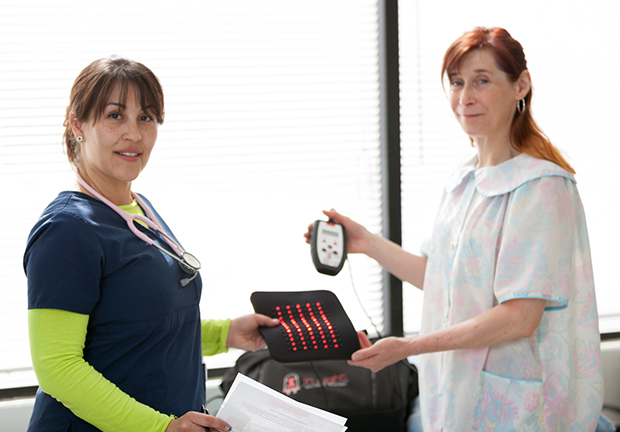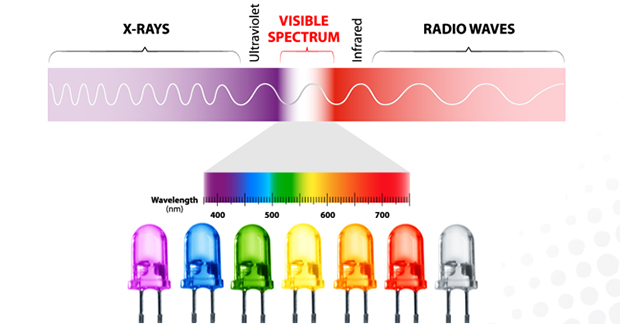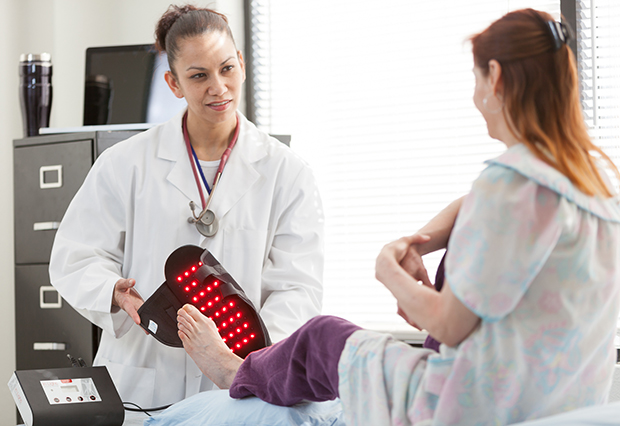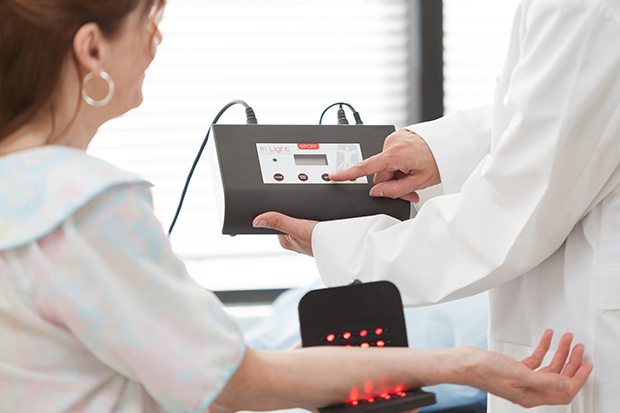
Discover the revitalizing power of light.
In Light Wellness Systems™ provides a dynamic and user-friendly polychromatic light therapy system intended for clinical, professional and home user applications.
LED polychromatic light therapy involves the use of light emitting diodes (LED) delivering red, blue, and infrared light to the skin. These three (3) wavelengths stimulate beneficial innate cellular responses increasing circulation and activating the release of nitric oxide.
Brilliant Light Energy
NASA studies demonstrate cells exposed to LED light therapy exhibit a 150% increase in cellular metabolism suggesting enhanced cellular repair and vitality. Medical researchers across the globe are currently investigating a wide array of physiologic benefits produced by LED light therapy.
LED light therapy is non-abrasive, non-invasive, painless, and restorative. It is safe in the clinic or at home for all ages and skin types.
What is Polychromatic Light Therapy?
The term ‘polychromatic’ denotes that more than one (1) wavelength is used simultaneously, meaning that each In Light Wellness Systems™ polychromatic light therapy pad has at least two (2) different wavelengths in the LEDs used.
What is LED Light?

What is LED Therapy?
In Light Wellness Systems™ is a photo-modulated (pulsed, light emitting diodes) device also known as low-level light therapy (LLLT). The infrared and visible red LEDs are the heart of the In Light Wellness Systems™ therapy system, providing gentle but powerful non-coherent light. In Light Wellness Systems™ uses a carefully timed sequence of settings, known as pulses, to create an environment in which change may occur more rapidly.

Who is Polychromatic Light Therapy for?
In Light Wellness Systems™ can be used both professionally in a clinic and by people at home as part of their continuing therapy. Common pad designs between clinical and home units allow clients to receive the same benefits at home as in the clinic.
Why choose In Light Wellness Systems?
Versatile
In Light Wellness Systems™ is a system, a group of components designed to work together. Pads are available in various shapes and sizes to suit different needs.
Easy to use
– Simple controls
– Automatic & manual override settings
– Flexible pads with flexible positioning and Velcro style straps
Powerful
200mw, 17º infrared LEDs, 4,500 millicandlaria (mcd) visible red LEDs. The effective “as measured” output per diode is 72Mw/cm2 for IR and 5Mw/cm2 for visible red.
Series 1 & 2 pads: why the difference?
Series 1 pads are for clients with compromised sensations, generally associated with any type of peripheral neuropathy. Series 1 pads’ LED spacing is less dense than Series 2 pads, reducing the risk of patient discomfort. When used in conjunction with a simple & commonsense protocol plan, the risk of patient discomfort is reduced to nearly zero.
Series 2 pads are for clients requiring additional power for indications such as acute pain management.
Cross contamination
The use of an inexpensive off the shelf plastic bag (baggie) as a barrier is simple, easy and effective. There is no requirement to wrap the area or pad in cling film.
Comprehensive manual
A detailed and comprehensive manual is available for all clinical units.

Why you should be interested in LED Therapy?
Effective, non-abrasive, non-invasive, and restorative
Polychromatic light therapy has been established as a useful tool to: Increase vascularity (circulation) by increasing the formation of new capillaries, which are additional blood vessels that replace damaged ones. New capillaries speed up the healing process by carrying more oxygen as well as more nutrients needed for healing, as well as carrying more waste products away.
Stimulate the production of collagen: Collagen is the most common protein found in the body. Collagen is the essential protein used to repair damaged tissue and to replace old tissue. It is the substance that holds cells together and has a high degree of elasticity. By increasing collagen production less scar tissue is formed at the damaged site.
Stimulate the release of adenosine triphosphate (ATP): ATP is the major carrier of energy to all cells. Increases in ATP allow cells to accept nutrients faster and get rid of waste products faster by increasing the energy level in the cell. Food turns into ATP before the cells utilize it. ATP provides the chemical energy that drives the chemical reactions of the cell.
Increase lymphatic system activity: Oedema, which is the swelling or natural splinting process of the body, has two basic components. The first is a liquid part, which can be evacuated by the blood system, and the second is comprised of the proteins that have to be evacuated by the lymphatic system. Research has shown that the lymph vessel diameter and the flow of the lymph system can be doubled with the use of light therapy. The venous diameter and the arterial diameters can also be increased. This means that both parts of oedema (liquid and protein) can be evacuated at a much faster rate to relieve swelling.
Reduce the excitability of nervous tissue: The photons of light energy enter the body as negative ions. This calls upon the body to send positive ions, like calcium among others, to the area being treated. These ions assist in firing the nerves, thereby relieving pain.
Stimulate fibroblastic activity that aids in the repair process: Fibroblasts are present in connective tissue and are capable of forming collagen fibers.
Increase phagocytosis: The process of scavenging or ingesting dead or degenerated cells by phagocyte cells for the purpose of clean up. This is an important part of the infection fighting process. Destruction of the infection and clean up must occur before the healing process can take place.
Induce a thermal like effect in the tissue: The light raises the temperature of the cells through a photochemical reaction.
Stimulate tissue granulation and connective tissue projections: Part of the healing process of wounds, ulcers or inflamed tissues.
Stimulate acetylcholine release: Acetylcholine causes cardiac inhibition, vasodilation, gastrointestinal peristalsis and other parasympathetic effects.
Typical uses for Polychromatic Light Therapy
Many people with complaints of pain associated with the following issues have reported positive results using LED light therapy:
- Acute neck and back pain
- Ankle problems
- Arthritis pain and restricted movement
- Bone spurs
- Bone fractures
- Bruises
- Burns
- Bursitis
- Carpal tunnel syndrome
- Deep muscle problems
- Golfer’s/tennis elbow
- Fractures
- Haematomas
- Open wounds with negligible formation of scar tissue
- Inflammation
- Leg pain
- Neuralgia
- Pain relief
- Peripheral neuropathy
- Pressure ulcers
- RSI/RSP
- Shoulder pain
- Sore backs
- Sprains
- Strains
- Swelling
- Tendon problems
- Tennis elbow
- Tight muscles
- Training (resistance/cardio)
- Reduction of scar tissue
- Wrist pain
Disclaimer
Statements contained herein have not been evaluated by the FDA. In Light Wellness Systems™ devices are not intended to diagnose, treat, cure or prevent any disease.
FDA product listing
All In Light Wellness Systems™ devices are FDA cleared. The FDA classification code is 890.5500, clearance K101894.
The In Light Wellness Systems™ manufacturing facility is an FDA registered facility and subject to regulation and inspection requirements.
Warranty & Repairs
Warranty: One year, unit replacement policy
Repairs: 1 week turnaround
